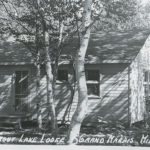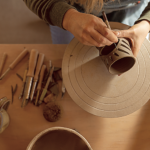For birch bark basket makers, summer is a season for harvesting bark. Many people recognize the distinctive look of the white papery layer of birch bark and know the trees by name. Baskets, canoes, shelters, containers and numerous other useful items have long been made by the Indigenous people of this area using birch bark.
Harvesting bark seems to be one of the most enticing parts of the basket making process for many people. Picture a hot, mid-summer day. You pull up in your car to the location where you will be harvesting, and the vehicle is surrounded by a swarm of horseflies as you come to a stop. The horseflies don’t seem to bother you much—they are more attracted to the car that had just been moving. As you proceed towards the woods, the brushy understory is dense and hard to move through. The mosquitoes slowly start to realize you are there, and soon their persistent buzz is followed by countless bites. This is one of those scenes where I have to laugh a little at myself. I’ll get up in the early morning to beat the heat of the day, and spend hours working so hard to get the materials I need, while only thinking fondly of the experience, and grateful to participate in it.
It really is a magical time. Everything in the woods is so full of life. Many of the plants in northern Minnesota are only in leaf for about half of the year, and this time of mid-summer feels as if all the plants, insects and animals are doing all they can to flourish. Walking through the same woods in the winter can feel quite silent. The same plants and insects are all still there, but they keep themselves tucked in until the warm weather returns.
As I walk through the woods, looking at each tree, I determine which ones look suitable for basket making. I test the bark on a few trees to see what it’s like. Birch trees can have vastly different characteristics, even within a close area. I check a little piece to see if the bark is thick or thin, or if it pulls into layers easily, or if it is brittle when bent in different directions. I often teach birch bark basketry, so each summer, I harvest the bark that I will use throughout the year for workshops and for my own work. The bark gets stored in a cool place, away from the sun and can stay pliable for years under the right conditions.
Birch bark is unique in the way it is harvested. The outer bark layer separates from the tree, and the inner bark stays put. There are many little details and considerations when harvesting bark in order to do it in a way that does not cause too much injury to the tree. The most common question is “does it kill the tree?” The answer is no, not if it is harvested properly, but this will always be a very big event for the tree that it must heal from. There are ways to help cause minimal damage to the tree, with care and knowledge. The area where the outer bark was taken can eventually heal over, a fascinating process that takes years. I actually love seeing trees that have been harvested years ago, and are still big and healthy, with a new layer of bark forming. The new bark that develops over the harvested area has an entirely different look to it. I like to wonder what became of that piece of bark, and who may have harvested it. The “second growth” bark changes each year and very slowly starts to look more like the rest of the tree, though it will always have different characteristics.
I think it is best to harvest bark with an intention for use, and certainly along with someone who is experienced. There are many rules and regulations that apply to the harvest of birch bark. You can’t just go do it. There are permits required to harvest on state, federal and county land, and there can be other specific permissions needed. Native communities have their own traditions and etiquettes pertaining to harvests. If you are a craftsperson wanting to work with birch bark, talking with private land owners that you know, and others who are cutting trees for firewood or other uses are a great place to start. Working with bark found on the ground is also an option and does not require special permits or permissions. With bark from dead trees, the only way to know if that piece is suitable for use is to try it. Does it crack when bent? Is it pliable? A little heat or warm water can encourage bark to bend smoothly.
Birch bark basketry traditions exist within the boreal forested areas around the world, and are practiced by people who live near the birch trees. Learning to work with bark from an experienced teacher is one of the best ways to learn more about the local landscape, the characteristics of the trees, and the traditions in the area.
Emily Derke is a basket maker in the Artisan Development program at North House Folk School, where traditional craft is taught on the shore of Lake Superior.




